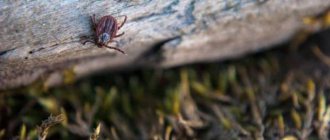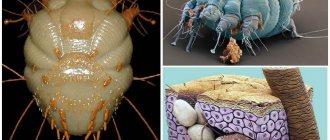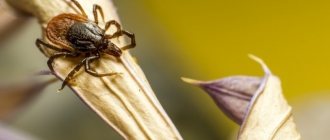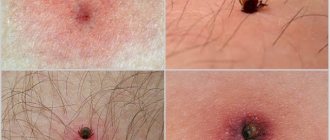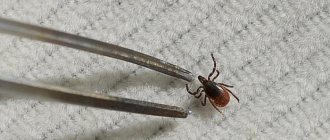Let us immediately note that it can be quite difficult to unambiguously identify a tick bite without detecting the parasite itself on the body. The fact is that the body’s reaction to a puncture of the skin by ixodids is approximately similar to that to the bites of various blood-sucking insects, and the external signs of bites from ticks and other bloodsuckers are generally similar.
For example, the photo below shows what a taiga tick bite looks like on human skin:
And here is a midge bite:
As you can see, the bite marks in this case are not very different in appearance.
However, taking into account individual details in the appearance of tick bites on the human body makes it possible to distinguish them with a certain accuracy from the bites of other arthropods. Knowledge of the biology of ixodid ticks, including the specifics of their attacks on animals and people, also helps to distinguish between bites.
We will consider all these nuances in more detail later, including situations where, based on the appearance of the wound, it is already possible to speak with a high probability of infection with a dangerous tick-borne infection.
What does a tick bite look like in most cases?
In most cases, a tick bite looks like a clearly visible spot with redness, in the center of which there is a wound with a diameter of about 1-2 mm. The photograph below shows examples from which it is clear why the wound turns out to be relatively large (the head of the parasite is literally completely immersed under the skin):
The wound caused by a puncture of the skin is covered with a crust within an hour after the tick detaches, while some swelling and redness remain.
On a note
It is the clearly visible wound in the center of the bite that is an important distinguishing feature of tick bites. In many other parasites, the blood-sucking organs are such thin proboscis that there are practically no traces left when they pierce the skin. Ticks have rather large mouthparts, and their feeding method requires the formation of a relatively large hole in the host's skin.
In ordinary cases, the next day the bite site no longer itches, after 2-3 days the swelling and redness subside, and after a few more days the crust at the site of the wound peels off.
After about 10-12 days, no trace remains at the site of the tick bite.
This happens normally when infection does not occur in the bite wound and the inflammatory process does not develop, and the wound itself is not disturbed, scratched or the protective crust on it is not damaged. However, often due to various undesirable factors the situation can become complicated, which is accompanied by the appearance of additional unpleasant symptoms.
For example, if an attached tick is incorrectly torn from the skin, even if the parasite remains unharmed (that is, no parts of its body remain in the wound), a dense lump often forms around the bite site, which is very itchy. This occurs due to tissue injury from the roughly pulled out mouthparts of the bloodsucker, literally glued to the skin with a case of congealed saliva.
Besides:
- When removing the parasite with your fingers, excessive pressure on the body leads to the squeezing of additional portions of saliva into the wound;
- Because of the itching, the resulting lump is usually scratched vigorously, which further intensifies the itching, promotes the spread of redness and can provoke infection and further suppuration of the bite site.
If the lump is lubricated with pain-relieving ointment in time and not disturbed, it gradually decreases in size and completely subsides after 4-5 days.
A more dangerous situation is when, when a tick is pulled out, its body is torn off from the head (gnathosoma), as a result of which the mouthparts remain in the wound. Removing them from here is not always easy, since they are difficult to grasp even with tweezers or tweezers from a manicure set - the gnathosoma of the tick is deeply immersed in the skin, and the rupture of its body usually occurs deeper than the level of the surface of the skin.
In this case, at the site of the bite, in addition to a spot of redness, a noticeable black dot remains - the same oral organs of the parasite.
If the detached head of the tick is not removed like a splinter, on the second or third day the tissue at the site of the bite will begin to tear, an abscess will form here, from which the remains of the tick will subsequently come out along with the oozing pus.
A painful abscess with swelling often forms. From the moment the tick comes off until the abscess ruptures and pus flows out of it, on average, 3-4 days pass; the abscess site will heal for several more days.
When the parasite is carefully unscrewed using special devices for removing ticks, approximately the same wound and swelling remains at the attachment site as what happens when the parasite detaches itself.
The picture below shows the sequence of correct twisting of the tick:
And here are photographs with examples of tick removal using various tick removers:
On a note
It should be borne in mind that if contaminants get into the wound, the consequence may be bacterial infection. Therefore, the site of the tick bite should be disinfected immediately after removing the attached parasite - for example, with brilliant green or an alcohol solution of iodine. It is only important to understand that this does not affect the likelihood of developing tick-borne encephalitis or borreliosis (if the tick was a carrier of the corresponding pathogens), but only helps prevent the unwanted development of a secondary bacterial infection in the wound.
In general, a tick bite can be described as mildly painful, itchy, accompanied by redness and swelling, but most importantly, unnoticeable until the parasite detaches. While the tick is attached to the skin and sucks blood, a person practically does not feel it.
As noted above, if the parasite has already detached itself from the skin, it will be difficult to understand just by the appearance of the bite that it was a tick. Often, based on certain signs, it is easier to understand that the bite was definitely not caused by a tick, but by another arthropod.
How do these parasites definitely not bite?
In all cases, ixodid ticks bite only to suck blood. They never attack a person in self-defense.
Besides:
- A tick bite is never extremely painful, never causes acute throbbing pain, or “burns.” All these signs are characteristic of the bites of arthropods, which try to protect themselves or their nests in this way and scare off a person primarily with the acute pain of a bite (bees, wasps, scorpions, etc.);
- The tick does not bite quickly and does not quickly run away from the bite site. The parasite needs a lot of time to choose the optimal site for suction, and it takes even more time to suck blood. That is, if a minute ago a person examined an area of the body and there was no parasite on it, and then a few minutes later a bite appeared on the same area, but the bloodsucker was not visible, it means that it was definitely not a tick that bit;
- The tick does not seriously injure a person with its bite; blood does not ooze from the wound left by it;
- With rare exceptions, tick bites do not cause a rapid, generalized reaction. During the first 1-2 days after the bite, headaches, fainting, heart problems, nausea and deterioration do not develop. Such symptoms may indeed occur later with the development of an infectious disease transmitted by a tick, but not earlier than after a few days of the incubation period (this usually takes several weeks). If such signs appeared in the first hours after the bite was discovered, then it was not a tick that bit.
On a note
The exception to the latter rule is the bite of the Australian paralysis tick Ixodes holocyclus. Its individuals, at all stages of their development, secrete a toxin in their saliva, leading to paralysis of the limbs in animals and people, as well as symptoms similar to those of polio (even death is possible). The first signs of paralysis after bites of these ticks appear within 6-7 hours. The species Ixodes holocyclus lives only in Australia, and in Eurasia such situations are excluded.
Photo of Ixodes holocyclus paralysis tick:
Another important sign: ticks never bite through clothing, even very thin ones (through tights, for example). Mosquitoes, midges, horseflies, spiders can bite through thin fabrics, wasps and bees can sting, but ticks never stick to the skin through clothing.
It is also useful to read: How to remove a tick from a dog at home
At the same time, under loose clothing - under wide pants, shirts, T-shirts, on the head under a hat - a tick may well bite.
What do they eat?
Where ticks live and what they feed on is of interest to many people who want to prevent encounters with these arthropods. According to the type of nutrition, arachnids can be divided into:
- Saprophages that feed exclusively on organic debris.
- On predators that parasitize plants and animals.
Feeding on plant juices, mites cause significant damage to agriculture. Scabies and field arachnids eat particles of human epidermis. Granary feeders feed on decaying plant remains, flour, and grain. For subcutaneous mites, the food is the fat of human hair follicles, while ear mites consume fat from the hearing aids of animals.
Having taken their place on a branch or blade of grass, blood-sucking predators await their prey. Having waited, they attach themselves to it using paws with claws and suction cups, and then gradually reach the feeding site. The victim of arachnids is usually not only humans, but also other representatives of ticks.
Parasites are carriers of infectious diseases, so their bite can be fatal to humans. Arachnids can go without food for about three years, but once they receive food, they increase in weight several times.
Differences between a tick bite and the bites of various insects
We have already mentioned the first important difference earlier: at the site of the tick bite there remains a red spot and a clearly visible wound, which gradually becomes covered with a crust. This is in contrast to mosquito bites, in the place of which only an itchy swelling remains, but without a visible insertion site for the proboscis.
Compared to the bites of most stinging insects, spiders and centipedes, tick bites are completely painless. Even mosquitoes that inject anesthetic substances into the wound do not do it so “skillfully”, and their injection immediately attracts attention with mild pain.
Tick bites differ from bed bug bites (and to some extent fleas) in that they are not collected in “paths” of 2-3 wounds. Each bug bites several times in one attack, moving 1-2 centimeters between bites, and as a result, characteristic “chains” of reddened bumps remain on the human body. The tick bites only once, after which it falls away from the body, and therefore leaves only one trace of a skin puncture on the skin.
On a note
It is quite easy to distinguish a tick bite from the bite of a scolopendra, tarantula or small poisonous snake: these animals leave two points at once at the skin puncture sites. Centipedes bite with two clearly visible jaws, spiders with two chelicerae, and snakes with two teeth. Consequently, there will be two clearly visible points at the sites of their bites. The tick pierces the skin with a saw-toothed hypostome in only one place.
By the shape of the wound itself, a tick bite can be distinguished from a leech bite. After sucking on a leech, due to the characteristic structure of its oral apparatus, the wound looks like a small even cross. In a tick, it simply looks like a dot. After the leech falls off, the wound continues to bleed for a very long time, which does not happen after tick bites.
An important characteristic difference between a tick bite and the bites of any other parasites is the development of annular migratory erythema when a victim is infected with Lyme borreliosis. This erythema is a clearly visible red ring around the bite site, gradually expanding and spreading across the skin (see examples in the photo below).
After bites of any other parasite, such a formation does not appear. Depending on the length of the incubation period of the disease in a particular person, erythema migrans occurs at different times - from several days to several months after the bite.
But it is impossible to judge whether a person is infected with the tick-borne encephalitis virus by the appearance of the bite - it does not appear outwardly.
Finally, the main feature that distinguishes tick bites from the bites of other blood-sucking or stinging arthropods: the tick always sucks blood for a long time. Even larvae and nymphs of the first instars, which require relatively little food, are attached to the skin for at least several days, and adult females, which suck the largest amount of blood, remain on the skin for more than a week. Therefore, in most cases, the attached parasite is found on the human body even before it detaches.
The opposite situations happen very rarely - they can arise, for example, during a multi-day hunting or fishing trip, on hiking trips, that is, during a long stay in the wild without the opportunity to undress, wash and examine the body. Here the tick can suck blood from a person under clothing for several days, after which it detaches.
This means that in a situation where, after a 2-3 hour walk in a park or in the forest, a person was found to have some kind of bite, but the parasite itself could not be found, this bite was not caused by a tick.
Meaning in nature and human life
It is difficult to find a place on Earth where these representatives of arachnids do not live. Ticks are found wherever possible: in the forest, in a personal plot, in a garden, and even in city parks and squares. All types differ in structure, color, and size.
Some of them cause irreparable harm to plants, others are parasitic on animals and humans, and still others are blood-sucking specimens.
People have been fighting them for a very long time, but the importance of ticks in nature should still be recognized.
For example, ixodid arthropods are the most dangerous to humans, as they carry deadly infectious diseases. Despite this, they play an important role in the ecosystem, as they regulate natural selection. If such a tick bites a weak animal, it will die, and strong ones will develop immunity. This helps maintain balance among animals on Earth. Thus, it follows that some representatives of arthropods, although of great importance for nature, still cause great harm to people.
What happens when a parasite is sucked on?
Ixodid ticks bite exclusively to feed on blood - this is their only source of food. To saturate the parasite needs:
- Get caught on the victim’s clothing or fur;
- Get to a place convenient for blood sucking;
- Pierce the skin and attach to the wound;
- Suck blood;
- Detach and leave the host's body.
It is important to understand that there are almost never situations in which a tick bites, but does not have time to attach itself and crawls away.
In general, finding a host and securing it in its skin is a complex process. The tick is usually found at the top of a grass stem with its front pair of legs extended forward. When a person or animal approaches, the parasite instantly grabs onto the host.
Then, from 2-3 minutes to an hour, the tick moves around the host’s body and looks for well-supplied areas with thin skin. Then the bite occurs:
- The parasite places the palps to the sides, which normally act as “sheaths” and cover the hypostome;
- The hypostome and chelicerae penetrate the skin;
- It releases saliva into the wound, containing many functional components (this includes anticoagulants that prevent blood clotting and thickening, painkillers, compounds that envelop the hypostome and partially spread in the intercellular space, gradually harden and form a kind of case that very reliably holds the parasite in the skin );
- Then the tick begins to suck blood, lymph and inflammatory infiltrate from the wound.
The photo below shows the proboscis (hypostome) of a tick:
And this is what a hypostome looks like under a scanning electron microscope:
Representatives of different species of ticks and individuals at different stages of their life cycle tend to choose different places on the body of the host for attachment. On the human body, these are most often the armpit areas, and then, in descending order of frequency of attachment, the following areas follow:
- Breast;
- Stomach;
- Hands (including between fingers);
- Buttocks and perianal area;
- Groin;
- Legs;
- Neck and head (especially the area behind the ears).
The photo below shows a tick attached to a child’s ear:
And here the parasite got into his throat:
It is noteworthy that in children, ticks are more often than in adults, attached to the head (including in the hair, often behind the ear) and sometimes even on the face - on the cheeks, on the chin.
At the same time, the areas of attachment are largely determined by how the person is dressed. If, for example, his whole body is covered with thick clothing, then the parasite can reach his head from his feet and attach itself here.
The duration of blood sucking depends on the sex of the parasite and the stage of its development. Thus, tick nymphs of all ages feed at each stage of their development for 3-6 days, and female nymphs feed on average a day longer than male ones. Adult males feed for about the same amount of time - 3-6 days, and adult females - on average from 8 to 14 days.
This is interesting
Some types of ticks can feed for either much less or much longer periods of time. For example, the larvae of Haemaphysalis kitaokai become engorged within 2-3 hours, and the females of Geochelone pardalis, which parasitize turtles, fall off on average only 60 days after attachment.
It is noteworthy that while feeding, the tick does not constantly suck blood. Short acts of sucking are followed by periods of rest, then by injecting another portion of saliva into the wound. Studies have shown that no more than 15% of the time the parasite is attached to the host is spent directly on blood sucking. This indicates a certain primitiveness of this method of feeding and to a certain extent reduces the survival rate of feeding ticks.
It is also useful to read: How a tick bites: details about the process when it digs into the skin
The photos below show female ticks engorged with blood:
Throughout the entire period of bloodsucking, the parasite not only fills the digestive tract with blood and inflammatory infiltrate of the host, but at the same time actively grows and develops. In nymphs, it is at this time that the rapid development of internal organs and the growth of body integument occurs, and in adult males and females, the maturation of the reproductive system occurs.
Therefore, by the way, during one feeding each tick sucks out more blood and other liquids than it weighs at the time of detachment. Within a few days of feeding on the host, most of the food consumed has time to be digested and spent on development and growth, and undigested components are excreted in excrement. As a result, female ticks, weighing 7-10 mg before feeding, absorb about 5500-8500 mg of food during attachment, but weigh only 900-1400 mg after falling off.
This is interesting
Almost no environmental factors can force an unsatiated tick to detach from its host. The fact is that the very fact of getting on the host’s body and attaching to it is a vital necessity for each individual individual. Thus, one female lays several thousand eggs, and not all of them are fertilized and only a portion hatch into larvae.
Of several thousand larvae, only a few will be able to find the first host, and all the rest will die either from hunger or from predators. Likewise, of the several thousand larvae that have molted into the first instar nymph, only a few will be able to feed on the next host. As a result, for every adult tick that attaches itself to a person or animal, there are millions of its dead counterparts who did not manage to do so. Therefore, it is biologically conditioned that if a tick has attached itself, it will detach itself only after saturation, and it is impossible to force it to do this earlier. He would rather die than miss the chance to be satiated to the end.
It is for this reason that methods of removing attached ticks using hot matches, oil or repellents are ineffective. Even if burned or suffocated by a drop of oil, the tick will not let go of its victim.
If the tick is full, it independently removes the gnathosoma from the skin. What will happen to it next depends on the type of parasite and the stage of development of the individual:
- In one- and two-host ticks, nymphs and larvae can remain on the host’s body, molt here, and after moving to the next instar, attach themselves again. This happens most often when parasitizing cattle;
- Adult males of some species, after detachment, go to look for females that have attached themselves to the same host in order to copulate with them. The photo below shows a lot of attached ticks of different ages in the dog’s ear;
- In three-host species, after each saturation, the larvae and nymphs fall away from the host, look for secluded shelters in the ground and under stones, where they molt, and sometimes overwinter, and then go in search of new hosts;
- Adult females of all species, after satiation, disappear and hide in random shelters on the ground. Here they wait for the eggs to fully mature and lay them, after which they die.
It is interesting that if in nymphs of all ages, larvae and adult males, nutrition contributes to the general development of the body, then in adult females, when feeding, the reproductive system first fully matures, and after fertilization, degradation of the digestive system begins with the parallel development of a large number of eggs. In fact, after complete saturation and development, the adult female is a living egg sac, practically incapable of further life. She can still move a short distance to find shelter on the ground, but here, after laying eggs, all that remains of her is actually the mouthparts and the shell of the idiosome.
Adult males also do not live long after feeding, but their lives are a little more eventful. They actively search for females, fertilize them, and can feed them several times. However, engorged adult males no longer survive the change of seasons and do not live to see the next year.
Where are ticks and their varieties found?
With the onset of warm weather, many people go out with their families or friends to the park or forest. A pleasant pastime can be ruined by a tick bite, which often leads to the development of a dangerous disease.
There are hundreds of species of ticks in nature, of which the most dangerous to humans are ixodid ticks. To minimize the likelihood of encountering this bloodsucker, you need to know the habitats of ticks, their habits and methods of protection against them.
Of all the species, only ixodid ticks choose the blood of humans, birds, and warm-blooded animals as food. This is a small arachnid, not exceeding a few millimeters when hungry. In a well-fed state, the size of the tick increases, and the female is usually larger than the male.
Dangerous diseases, such as encephalitis and borreliosis, are carried by two types of ticks: European forest ticks and taiga ticks.
They live in grass and tall bushes, preferring forest areas overgrown with tall grass (7 cm and above). The lower the grass, the safer this place is for humans and animals. Also, ticks do not remain in trampled clearings or asphalt areas.
The type of forest for the ixodid tick practically does not matter; they are found in spruce, birch, and mixed forests. They only dislike coniferous forests. Encephalitis ticks also live in pastures, meadows, on roadsides and even in city squares and parks; their habitat in Russia is not limited only to forests.
Forest ticks are small in size, reaching a length of 2-5 mm in a hungry state. Such arachnids belong to the subclass of arthropods and live almost all over the world, except Antarctica. The diversity of parasite species differs depending on the place of their life activity and the nature of their feeding.
Ixodid ticks, numbering almost 700 species, prefer to settle in damp forests, densely overgrown grassy meadows, and on low trees and shrubs.
In nature, their diet consists of plant debris, soil fungi and small arthropods, but they also love to drink the blood of animals and people. There are other types of such parasites:
- gamasid, red beetles and argasid mites, which are also capable of consuming human and mammalian blood;
- dust mites (saprophytes), whose life is spent in living quarters with people, prefer to feed on dead particles of the epidermis;
- subcutaneous (Demodex) - live in the upper layer of the human epidermis and at the base of the hair follicles; they are tiny in size, so they can only be seen under a microscope.
Tick habitats
Optimal living conditions where ticks are found:
- Regions with high humidity, at least 80%;
- Slopes warmed by the sun with thick grass and shrubs up to 1 m high;
- The main habitat of ticks is: forest edges, clearings, ravines with dense grass;
- In the shade of deciduous trees there are thickets of ferns, among low young trees (aspen, hazel, etc.);
- Most often, parasites live in coastal thickets near rivers, ponds, lakes and streams, where forest animals come to drink;
- Soil surface with fallen leaves or grass clippings.
“Bloodsuckers” can settle on stumps and fallen dry trees, so a tourist should think carefully before sitting down to relax in the forest on the first stump he encounters. The most unsuitable places for ticks to live: hills, areas without grass and plants, dry undergrowth in a pine forest, etc.
What weather and climate do ticks like?
Ixodids live on almost all continents and in almost all climatic zones. They have been found even beyond the Arctic Circle, which indicates their high adaptability to the most extreme living conditions.
The largest number of species of ticks are found in tropical and subtropical forests; they love and look for places with high levels of humidity, multi-tiered vegetation and a large number of prey-feeders.
In areas with a temperate climate, ticks are also widespread.
They are found almost throughout the entire territory of Russia, from the taiga to semi-deserts. Carriers of borreliosis (Lyme disease) are found in the Krasnodar Territory, Moscow and the Moscow region.
The risk of contracting hemorrhagic fever through a bite is high in the Caucasus, Volgograd and Rostov regions. Viral encephalitis in Russia is carried by ticks mainly in the following regions: the Far East, Karelia, most regions of the Central District, Northwestern District, Volga region.
Lovers of outdoor recreation run the risk of encountering the parasite in the following places:
Ticks' favorite weather is humid and warm. A particularly favorable time for their reproduction is a prolonged spring, warm and rainy summer. On a dry and hot day, encountering a tick is unlikely. The bloodsucker does not tolerate direct sunlight.
Where to expect an attack
Ticks need feeders to survive. Therefore, they are located exactly where many people and animals pass. They climb to the very top of bushes or blades of grass and wait for their prey. When walking along forest roads or through coastal thickets, you should not touch or touch low-hanging branches, bushes and tall grass with your hands.
Do not sit on a litter of leaves or branches.
Ticks have no eyes. Thanks to their excellent sense of smell, they sense the approach of humans and warm-blooded animals from 10 meters away. In anticipation of their approach, the parasite extends its forelimbs to latch on.
It is on the front legs of the tick that the olfactory organs are located. Moving them from side to side, the tick understands from which side the victim is approaching and tries to grab onto it. Thanks to special hooks and suction cups at the end of the legs, the tick firmly clings to everything it touches.
Most often, the parasite sneaks into a person’s collar and attaches itself to the neck or head. A person does not feel the bite because, together with its saliva, the tick injects a substance with an analgesic effect into the bite site. Then it plunges its proboscis under the victim's skin and begins to suck blood.
The special cementing properties of saliva firmly fix it in this position. Once satisfied, the tick disappears. A well-fed tick increases in size up to a centimeter.
Among the total number of ixodid ticks, about 5% of individuals are carriers of dangerous diseases. They can cause the following serious diseases:
- Tick-borne encephalitis is a life-threatening disease.
- Borreliosis is a bacterial disease that, in the absence of timely treatment, leads to irreversible changes in the brain and death.
- Piroplasmosis is a disease of domestic animals transmitted through tick bites.
- Hemorrhagic fever.
Where do ticks hide in winter?
In winter, ticks are inactive and hide in dry forest litter, in pastures, and in barns with livestock. When the earth begins to warm up with the spring sun, the parasites awaken from hibernation. With the appearance of the first thawed patches, they climb up and begin to look for their “owner”.
The tick makes its first attempts to attach itself at the end of March - beginning of April. Precautionary measures should be taken from now on. At the beginning of spring, night frosts inhibit tick activity.
But with the advent of warmth, the parasites begin active hunting. The danger of an encephalitis tick bite remains until the end of the mating season and the female lays eggs. This is the end of spring and all summer.
The periods of tick activity depend on the climatic conditions in their habitats. In some areas they attack as soon as the air warms up to 3 degrees (for example, in Karelia).
In others, their activity begins with the onset of 15-degree heat. In different zones of Russia, ticks are found from the beginning of April to the end of September. It happened that parasites were found on hunting dogs in October and even in November.
Can ticks live on trees and fall from them?
Many people are afraid to be under trees during tick season. They believe that ticks are found on trees and fall from them onto people. Actually this is not true. Ticks do not climb trees; it is too high for them. The maximum height of bushes and thickets of grass, where they climb in search of prey, is one and a half meters.
Only adults can climb to such a height. They are the ones who hunt people and large animals.
Tick larvae and nymphs guard small mammals and rodents at a small height from the ground. However, ticks can hide on the stumps of felled trees. Therefore, you should not sit on them during forest walks.
Possible consequences of an Ixodid tick attack
Tick bites can lead to consequences that vary both in their external manifestations and in the danger to the health and life of the victim.
If we talk about bites in humans, these consequences include:
- A normal temporary reaction to a bite is redness and slight itching after the tick detaches;
- Inflammation and suppuration of the wound, in which there was an accidental infection or the head of the tick remained after its removal;
- An allergic reaction, usually limited to swelling, spreading redness over the skin and a rash around the bite site. Anaphylaxis in response to taiga and dog tick bites has not been documented;
- Infection with dangerous tick-borne infections. In Russia and neighboring countries, such infections include the tick-borne encephalitis virus and Lyme disease (borreliosis); in other countries, ticks can carry the pathogens of spotted fever and Q fever.
Pets become infected from ticks with piroplasmosis, ehrlichiosis, hepatozoonosis and other diseases. Wild animals and cattle on heavily tick-infested pastures can die from exhaustion if they are infested with too many ticks.
If a tick is infected with one or another infection, transmission of the pathogen begins almost immediately after cutting through the skin, when the parasite injects the first portion of saliva into the wound. The longer a tick feeds, the more infected saliva it transfers to its host and the greater the likelihood of subsequent infection.
Of the two most common tick-borne infections in Eurasia, encephalitis is considered much more dangerous than borreliosis, since there is no specific effective treatment against TBE. Borreliosis, with timely diagnosis, can be treated quickly and effectively with available antibiotics.
Moreover, even in the most dangerous areas for tick-borne encephalitis, the frequency of infection with this disease does not exceed 0.24% of the total number of bites. That is, out of 10,000 tick bites, only 24 of those bitten develop tick-borne encephalitis.
Danger and harm
Ixodid representatives of the species pose a great danger to both representatives of the animal world and people. The taiga tick, or, as it is also called, the encephalitis tick, is in first place in terms of danger, as it is a carrier of diseases such as borrelosis, encephalitis, ehrlichiosis and other diseases.
Due to the fact that the food of these arachnids is blood, infection occurs after a bite. The causative agents of fatal diseases enter the human body along with the saliva of arthropods. Other types of arachnids can also harm human health, for example, subcutaneous scabies mites, which can be carriers of diseases such as dermatitis and scabies.
Saprophages, which seem harmless at first glance, can also harm people. Due to their small size, there are no places inaccessible to them, so they live almost everywhere:
- flour - feeds on flour, cereals, grains and thereby destroys a large amount of food;
- arachnoid - destroys a garden or indoor plant;
- dust - eats particles of the epidermis, dust, and can also cause an allergic reaction and asthma in humans.
- ear - causes inconvenience to cats and dogs, moving into their ears.
Ticks, as it turns out, can be both beneficial and harmful to humans and nature as a whole. They occupy a certain ecological niche and fulfill their direct responsibilities.
Is it possible to understand from the appearance of the bite that an infection has occurred?
It is impossible to determine by the appearance of a tick whether it is infected with an infection, just as it is impossible to determine from the bite itself whether transmission of the pathogen has occurred. Directly after a bite and immediately after it, tick-borne infections do not manifest themselves in any way, therefore, they do not affect the appearance of the wound in any way.
On a note
As noted above, after a few days annular migratory erythema may appear, which is a sign of infection with borreliosis.
The first symptoms of encephalitis and borreliosis develop on average after 2-3 weeks, but sometimes the incubation period can be different. Thus, borreliosis sometimes manifests itself within 4-5 days after the bite, and in other cases the development of infection is delayed for several weeks. Therefore, a person who has been bitten needs to remember about the bite itself, so that when the first signs of illness appear, immediately consult a doctor.
A few more photos
A tick has attached itself to a child's ear:
And this photo shows signs of an allergy to a tick bite:
Removing a tick with a thread:
Interestingly, ixodid ticks parasitize not only warm-blooded animals, but also reptiles:
What to do next
In most cases, treating a bite with antiseptics is sufficient for first aid to the bitten person. If the bite occurred in a region epidemiologically dangerous for tick-borne encephalitis, it is highly advisable to save the tick for analysis, as this will help to find out whether there is a risk of infection after the incident.
To do this you need:
- Deliver the parasite to the laboratory, where it can be tested for infection with the tick-borne encephalitis virus. If the bite occurred in a region unfavorable for TBE, the victim will receive emergency prophylaxis by administering immunoglobulin against tick-borne encephalitis, and after two weeks he will need to have an additional blood test. This is all relevant if the victim does not have a TBE vaccine;
- If it is impossible to deliver the tick to the laboratory, you need to carefully monitor the condition of the bitten person for at least 4 weeks, remembering the date of the bite. If the slightest signs of illness appear - increased body temperature, headaches, nervous system disorders - the bitten person should be immediately taken to the hospital for diagnosis and treatment.
On a note
As for pets, the incubation period for piroplasmosis is on average 1-2 weeks, and if at this time the pet shows signs of illness, it should be immediately taken to the veterinarian.
There is no need to take any medications on your own or start any treatment after a tick bite. None of the tick-borne infections can be treated at home. Only doctors prescribe and carry out such treatment.
